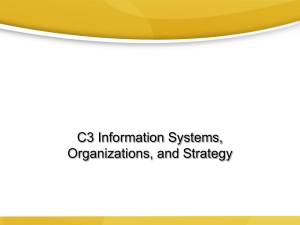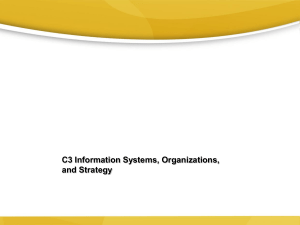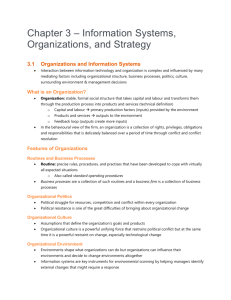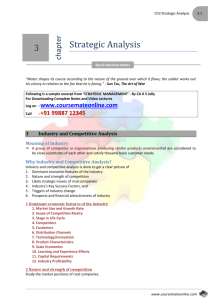INFO1400 Chapter 3 Review Questions 1. Which features of
advertisement
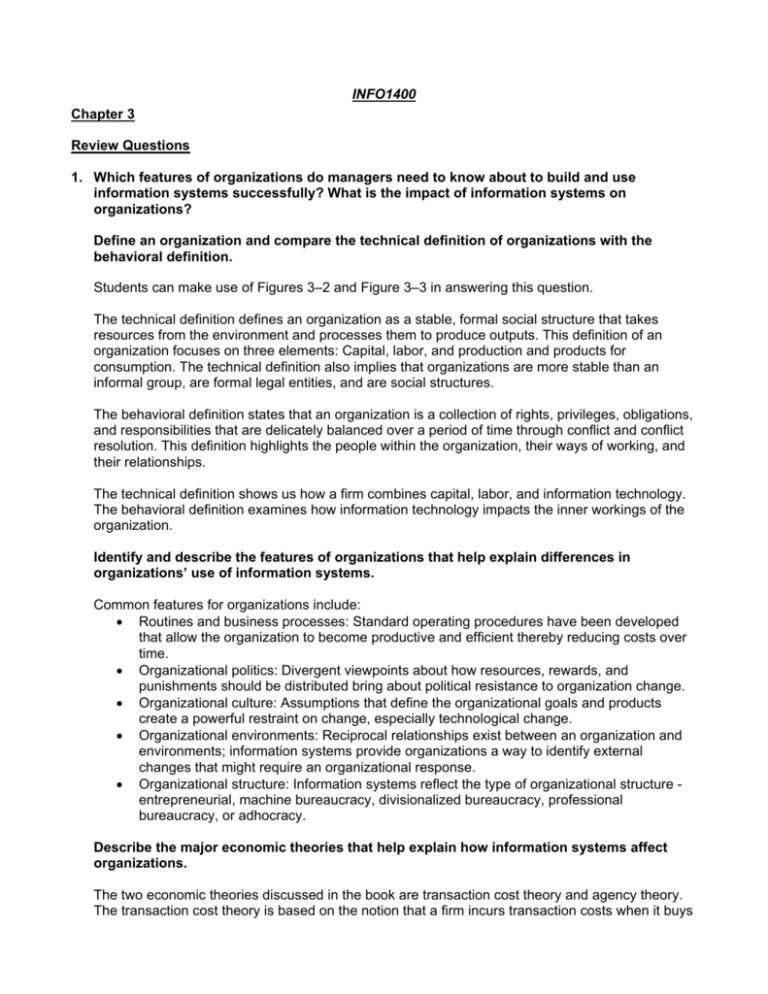
INFO1400 Chapter 3 Review Questions 1. Which features of organizations do managers need to know about to build and use information systems successfully? What is the impact of information systems on organizations? Define an organization and compare the technical definition of organizations with the behavioral definition. Students can make use of Figures 3–2 and Figure 3–3 in answering this question. The technical definition defines an organization as a stable, formal social structure that takes resources from the environment and processes them to produce outputs. This definition of an organization focuses on three elements: Capital, labor, and production and products for consumption. The technical definition also implies that organizations are more stable than an informal group, are formal legal entities, and are social structures. The behavioral definition states that an organization is a collection of rights, privileges, obligations, and responsibilities that are delicately balanced over a period of time through conflict and conflict resolution. This definition highlights the people within the organization, their ways of working, and their relationships. The technical definition shows us how a firm combines capital, labor, and information technology. The behavioral definition examines how information technology impacts the inner workings of the organization. Identify and describe the features of organizations that help explain differences in organizations’ use of information systems. Common features for organizations include: Routines and business processes: Standard operating procedures have been developed that allow the organization to become productive and efficient thereby reducing costs over time. Organizational politics: Divergent viewpoints about how resources, rewards, and punishments should be distributed bring about political resistance to organization change. Organizational culture: Assumptions that define the organizational goals and products create a powerful restraint on change, especially technological change. Organizational environments: Reciprocal relationships exist between an organization and environments; information systems provide organizations a way to identify external changes that might require an organizational response. Organizational structure: Information systems reflect the type of organizational structure entrepreneurial, machine bureaucracy, divisionalized bureaucracy, professional bureaucracy, or adhocracy. Describe the major economic theories that help explain how information systems affect organizations. The two economic theories discussed in the book are transaction cost theory and agency theory. The transaction cost theory is based on the notion that a firm incurs transaction costs when it buys goods in the marketplace rather than making products for itself. Traditionally, firms sought to reduce transaction costs by getting bigger, hiring more employees, vertical and horizontal integration, and small-company takeovers. Information technology helps firms lower the cost of market participation (transaction costs) and helps firms shrink in size while producing the same or greater amount of output. The agency theory views the firm as a nexus of contracts among interested individuals. The owner employs agents (employees) to perform work on his or her behalf and delegates some decisionmaking authority to the agents. Agents need constant supervision and management, which introduces management costs. As firms grow, management costs rise. Information technology reduces agency costs by providing information more easily so that managers can supervise a larger number of people with fewer resources. Describe the major behavioral theories that help explain how information systems affect organizations. Behavioral theories, from sociology, psychology, and political science, are useful for describing the behavior of individual firms. Behavioral researchers theorize that information technology could change the decision-making hierarchy by lowering the costs of information acquisition and distribution. IT could eliminate middle managers and their clerical support by sending information from operating units directly to senior management and by enabling information to be sent directly to lower-level operating units. It even enables some organizations to act as virtual organizations because they are no longer limited by geographic locations. One behavioral approach views information systems as the outcome of political competition between organizational subgroups. IT becomes very involved with this competition because it controls who has access to what information, and information systems can control who does what, when, where, and how. Explain why there is considerable organizational resistance to the introduction of information systems. There is considerable organizational resistance to new information systems because they change many important organizational dimensions, such as culture, structure, politics, and work. Leavitt puts forth a model that says that changes in technology are absorbed, deflected, and defeated by organizational task arrangements, structures, and people. In this model the only way to bring about change is to change the technology, tasks, structure, and people simultaneously. In a second model, the authors speak of the need to unfreeze organizations before introducing an innovation, quickly implementing the new system, and then refreezing or institutionalizing the change. Describe the impact of the Internet and disruptive technologies on organizations. The Internet increases the accessibility, storage, and distribution of information and knowledge for organizations; nearly any information can be available anywhere at any time. The Internet increases the scope, depth, and range of information and knowledge storage. It lowers the cost and raises the quality of information and knowledge distribution. That is, it lowers transaction costs and information acquisition costs. By using the Internet, organizations may reduce several levels of management, enabling closer and quicker communication between upper levels of management and the lower levels. The Internet also lowers agency costs. Disruptive technologies caused by technological changes can have different effects on different companies depending on how they handle the changes. Some companies create the disruptions and succeed very well. Other companies learn about the disruption and successfully adopt it. Other companies are obliterated by the changes because they are very efficient at doing what no longer needs to be done. Some disruptions mostly benefit the firm. Other disruptions mostly benefit consumers. 2. How does Porter’s competitive forces model help companies develop competitive strategies using information systems? Define Porter’s competitive forces model and explain how it works. This model provides a general view of the firm, its competitors, and the firm’s environment. Porter’s model is all about the firm’s general business environment. In this model, five competitive forces shape the fate of the firm: traditional competitors new market entrants substitute products and services customers suppliers Describe what the competitive forces model explains about competitive advantage. Some firms do better than others because they either have access to special resources that others do not, or they are able to use commonly available resources more efficiently. It could be because of superior knowledge and information assets. Regardless, they excel in revenue growth, profitability, or productivity growth, ultimately increasing their stock market valuations compared to their competitors. List and describe four competitive strategies enabled by information systems that firms can pursue. The four generic strategies, each of which is often enabled by using information technology and systems include: Low-cost leadership: Lowest operational costs and the lowest prices. Product differentiation: Enable new products and services, or greatly change the customer convenience in using existing products and services. Focus on market niche: Enable a specific market focus and serve this narrow target market better than competitors. Strengthen customer and suppliers: Tighten linkages with suppliers and develop intimacy with customers. Describe how information systems can support each of these competitive strategies and give examples. Low-cost leadership: Use information systems to improve inventory management, supply management, and create efficient customer response systems. Example: Wal-Mart. Product differentiation: Use information systems to create products and services that are customized and personalized to fit the precise specifications of individual customers. Example: Google, eBay, Apple, Lands’ End. Focus on market niche: Use information systems to produce and analyze data for finely tuned sales and marketing techniques. Analyze customer buying patterns, tastes, and preferences closely in order to efficiently pitch advertising and marketing campaigns to smaller target markets. Example: Hilton Hotels, Harrah’s. Strengthen customer and supplier intimacies: Use information systems to facilitate direct access from suppliers to information within the company. Increase switching costs and loyalty to the company. Example: IBM, Amazon.com Explain why aligning IT with business objectives is essential for strategic use of systems. The basic principle of IT strategy for a business is to ensure the technology serves the business and not the other way around. The more successfully a firm can align its IT with its business goals, the more profitable it will be. Business people must take an active role in shaping IT to the enterprise. They cannot ignore IT issues. They cannot tolerate failure in the IT area as just a nuisance to work around. They must understand what IT can do, how it works, and measure its impact on revenues and profits. 3. How do the value chain and value web models help businesses identify opportunities for strategic information system applications? Define and describe the value chain model. The value chain model highlights specific activities in the business where competitive strategies can best be applied and where information systems will most likely have a strategic impact. The model identifies specific, critical leverage points where a firm can use information technology most effectively to enhance its competitive position. The value chain model views the firm as a series of basic activities that add a margin of value to a firm’s products or services. The activities are categorized as either primary or support activities. Primary activities are most directly related to production and distribution of the firm’s products and services, which create value for the customer. Support activities make the delivery of primary activities possible and consist of organization infrastructure. A firm’s value chain can be linked to the value chains of its suppliers, distributors, and customers. Explain how the value chain model can be used to identify opportunities for information systems. Information systems can be used at each stage of the value chain to improve operational efficiency, lower costs, improve profit margins, and forge a closer relationship with customers and suppliers. Organizations can use information systems to help examine how value-adding activities are performed at each stage of the value chain. Information systems can improve the relationship with customers (customer relationship management systems) and with suppliers (supply chain management systems) who may be outside the value chain but belong to an extended value chain. Information systems can help businesses track benchmarks in the organization and identify best practices of their particular industries. After analyzing various stages in the value chain, an organization can devise a list of candidate applications for information systems. Define the value web and show how it is related to the value chain. A value web is a collection of independent firms that use information technology to coordinate their value chains to collectively produce a product or service. It is more customer driven and operates in a less linear fashion than the traditional value chain. The value web is a networked system that can synchronize the business processes of customers, suppliers, and trading partners among different companies in an industry or in related industries. Explain how the value web helps businesses identify opportunities for strategic information systems. Information systems enable value webs that are flexible and adaptive to changes in supply and demand. Relationships can be bundled or unbundled in response to changing market conditions. Firms can accelerate their time to market and to customers by optimizing their value web relationships to make quick decisions on who can deliver the required products or services at the right price and location. Information systems make it possible for companies to establish and operate value webs. Describe how the Internet has changed competitive forces and competitive advantage. The Internet has nearly destroyed some industries and severely threatened others. The Internet has also created entirely new markets and formed the basis of thousands of new businesses. The Internet has enabled new products and services, new business models, and new industries to rapidly develop. Because of the Internet, competitive rivalry has become much more intense. Internet technology is based on universal standards that any company can use, making it easy for rivals to compete on price alone and for new competitors to enter the market. Because information is available to everyone, the Internet raises the bargaining power of customers, who can quickly find the lowestcost provider on the Web. 4. How do information systems help businesses use synergies, core competencies and network-based strategies to achieve competitive advantage? Explain how information systems promote synergies and core competencies. A large corporation is typically a collection of businesses that are organized as a collection of strategic business units. Information systems can improve the overall performance of these business units by promoting synergies and core competencies. Describe how promoting synergies and core competencies enhances competitive advantages. The concept of synergy is that when the output of some units can be used as inputs to other units, or two organizations can pool markets and expertise, these relationships lower costs and generate profits. In applying synergy to situations, information systems are used to tie together the operations of disparate business units so that they can act as a whole. A core competency is an activity for which a firm is a world-class leader. In general, a core competency relies on knowledge that is gained over many years of experience and a first-class research organization or simply key people who stay abreast of new external knowledge. Any information system that encourages the sharing of knowledge across business units enhances competency. Explain how businesses benefit by using network economics. In a network, the marginal costs of adding another participant are almost zero, whereas the marginal gain is much larger. The larger the number of participants in a network, the greater the value to all participants because each user can interact with more people. The availability of Internet and networking technology has inspired strategies that take advantage of the abilities of the firm to create networks or network with each other. In a network economy, information systems facilitate business models based on large networks of users or subscribers that take advantage of network economies. Internet sites can be used by firms to build communities of users that can result in building customer loyalty and enjoyment and build unique ties to customers, suppliers, and business partners. Define and describe a virtual company and the benefits of pursuing a virtual company strategy. A virtual company uses networks to link people, assets, and ideas, enabling it to ally with other companies to create and distribute products and services without being limited by traditional organizational boundaries or physical locations. One company can use the capabilities of another company without being physically tied to that company. The virtual company model is useful when a company finds it cheaper to acquire products, services, or capabilities from an external vendor or when it needs to move quickly to exploit new market opportunities and lacks the time and resources to respond on its own. 5. What are the challenges posed by strategic information systems and how should they be addressed? List and describe the management challenges posed by strategic information systems. Information systems are closely intertwined with an organization’s structure, culture, and business processes. New systems disrupt established patterns of work and power relationships, so there is often considerable resistance to them when they are introduced. Implementing strategic systems often requires extensive organizational change and a transition from one sociotechnical level to another. Such changes are called strategic transitions and are often difficult and painful to achieve. Moreover, not all strategic systems are profitable. They are expensive and difficult to build because they entail massive sociotechnical changes within the organization. Many strategic information systems are easily copied by other firms so that strategic advantage is not always sustainable. The complex relationship between information systems, organizational performance, and decision making must be carefully managed. Explain how to perform a strategic systems analysis. Managers should ask the following questions to help them identify the types of systems that may provide them with a strategic advantage. 1. What is the structure of the industry in which the firm is located? Analyze the competitive forces at work in the industry; determine the basis of competition; determine the direction and nature of change within the industry; and analyze how the industry is currently using information technology. 2. What are the business, firm, and industry value chains for this particular firm? Decide how the company creates value for its customers; determine how the firm uses best practices to manage its business processes; analyze how the firm leverages its core competencies; verify how the industry supply chain and customer base are changing; establish the benefit of strategic partnerships and value webs; clarify where information systems will provide the greatest value in the firm’s value chain. 3. Have we aligned IT with our business strategy and goals? Articulate the firm’s business strategy and goals; decide if IT is improving the right business processes and activities in accordance with the firm’s strategy; agree on the right metrics to measure progress toward the goals.
